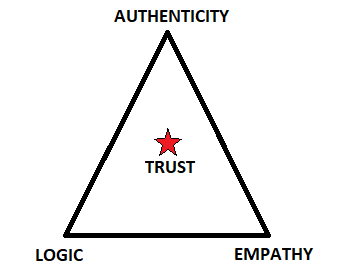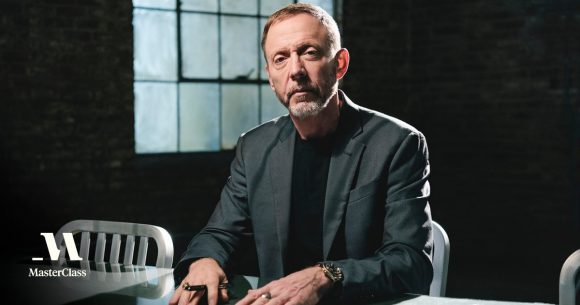CONFLICT, NEGOTIATION, AND POWER A Course Review of COM 440 by Bailey Ryan-Beyene
February 23, 2021
As a senior Strategic and Corporate Communication student with a strong interest in justice and public policy, I took Conflict, Negotiation, and Power as my final elective. I felt this course would provide me with the skills I need to incite social change and thrive instead of hide when faced with conflict, and it did exactly that. Through relevant books, role playing, and open discussions, I learned how to turn difficult conversations into productive interactions. This course prepares students to plan for possible contingencies to ensure they are always effectively communicating and reaching their desired outcomes.

Francis Frei’s ‘Trust Triangle
One of the fundamental concepts of communicating in general, and especially when there are conflicting views and goals, is to build trust with your audience. You must be open and honest with your audience so that they will be open and honest with you. We learned to share personal and professional background, like relevant accomplishments and failures, to build your reputation and image. The main concept covered in this course is how to approach difficult situations and allow dialogue to flow freely. We covered the importance and principles of recognizing when people feel uncomfortable or unsafe and how to change the mood so that everyone feels comfortable speaking. Another main concept is that of goal oriented communication. We learned to identify our personal goals and the audience’s goals to create a communication plan that will achieve those goals. We learned how to define our personal brand and use that to build relationships and tailor our presentation. You must identify your ultimate goal for the relationship then break it down into individual interactions with their own goals. Each interaction has its own goal, all related to achieving the ultimate goal.

Chris Voss, author of Never Split the Difference
My main takeaway from this course was that “every conversation is a crucial conversation,” which we learned reading Crucial Conversations by Kerry Patterson, Joseph Grenny, Ron McMillan, and Al Switzer. In every conversation, but especially in the workplace and in communication where we are trying to change behaviors, stakes are high, opinions vary, and emotions run strong. When applying for a job, hiring and firing employees, getting a new client, promoting a new product or simply briefing your team in a meeting, all of these elements will be present and this course instructed students on how to effectively communicate under these conditions. Many people struggle to properly convey their message and get the results they seek when they are under pressure or confront negative feedback. Crucial Conversations covers both organizational and interpersonal communication so that students can maintain workplace and customer relationships. The book specifically focuses on how to turn around a conversation that feels like a lost cause. Speak Up & Succeed! by Nance Rosen also addressed how to overcome this issue, teaching us that “a ‘no’ is as good as a ‘yes’” because it gives us an understanding of where our audience is at and an opportunity to redirect or reframe our messaging. The book also mapped out communication strategies for different scenarios and objectives, such as team briefings and meetings, persuasive presentations, and training sessions. Nance Rosen virtually joined the class to share her own experiences in practicing the book’s teachings. The final book we read was called Never Split the Difference by Chris Voss, a former F.B.I. hostage negotiator. We also viewed his masterclass on hostage negotiation, which showed example scenarios. Chris Voss focused on interpersonal communication and using tone of voice and similarity in guiding conversations to reach a mutual understanding. The professor also shared material and stories from his personal professional experiences to show us how the concepts we learned actually transfer to real-world situations. He showed us how he negotiated price and built a team. He also explained how he would and has fired people, using a combination of tools provided in the readings, such as the accusation audit, where every bad thought is laid out in the beginning so there are no misconceptions. Hearing experiences from the professionals who actually participate in the communication we are studying showed us exactly when and how these concepts would be used. The lessons we learned also came from multiple fields, from marketing, to law enforcement, to real estate, showing just how widespread and useful understanding how to communicate effectively when tensions are high is.
The course was structured around open discussion and participation. We began every class by sharing our own experiences with conflict, negotiation, and power. Students shared stories about work, school, friendships, families, another example of how these interactions and skills show up all around us. The class took place around the 2020 election, so we were able to analyze and examine the aspects of conflict, negotiation, and power within the presidential and vice presidential debates. We also role-played negotiation scenarios in class. Two students role played as a shopper and bike salesman. Another two students played as a renter and a landlord. When the scene was complete, we went over the strengths and weaknesses of the players. This allowed us to put the concepts we just learned into practice and revise our strategies.
About two months into the course, I got an internship with a congressman’s reelection campaign and I was thrilled to use what I had just learned to win an election. My responsibilities were to call hundreds of voters a day and persuade them to vote for our candidate. I knew this course would be extremely helpful because the conversations I was having were very crucial. The stakes were high: a congressional seat was open, the election was only a month away, and I only had a few minutes over the phone to get my message across and achieve my desired results. Opinions varied greatly because I was advocating for a democratic candidate against a republican in a primarily conservative district. And of course, in the political sphere, emotions run high. These are decisions that will impact every aspect of life. We are in a pandemic so people are looking to the government for help. People tend to form very strong opinions about candidates. Finally, I had strong emotions about wanting to win this election. Because I was taking this course alongside my work, I was able to recognize when people felt uncomfortable and redirect the conversation so voters could be open and honest with me. I was able to turn a “no” into a “yes” or “I’m listening.” I learned to quickly identify voter needs and wants and tailor my conversation to meet those needs. I made promises I knew I could keep so voters would trust and remember me.
I believe this is the most relevant class students of communication can take. This course synthesizes everything we have learned about communication, while preparing us for when our messages don’t stick the way we intended. It also helps to prevent messages from being misconstrued or unsuccessful. This course provides students with all the tools they need to effectively communicate when it is imperative that they do so.


